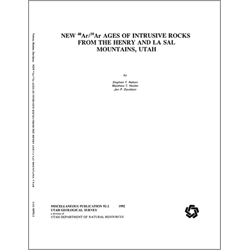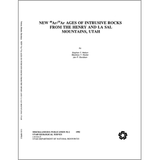New 40Ar/39Ar ages of intrusive rocks from the Henry and La Sal Mountains, Utah (MP 92-2)
By: S. T. Nelson, M. T. Heizler, and J. P. Davidson
Previously published Eocene and late-Oligocene K-Ar ages of intrusive rocks of the Henry and La Sal Mountains are bimodal whereas sphene and zircon fission-track ages are exclusively late Oligocene. The apparent discordance between ages from the two techniques makes it difficult to understand the igneous activity in terms of regional geologic and tectono-magmatic events. Results of new 40Ar/39Ar analyses reported here indicate that intrusive activity spanned several million years during late Oligocene time and forms a time, as well as a spatial, link between magmatism in the San Juan and Reno-Marysvale volcanic fields to the east and west respectively. Eocene K-Ar ages are shown to be the result of two discrete effects. First, excess argon is manifested in some samples by a trapped component of argon with a 40Ar/39Ar ratio that exceeds the atmospheric value. We interpret other apparent Eocene K-Ar ages to result from heterogeneous excess argon, or inherited argon residing in incompletely outgassed hornblende xenocrysts in the rock.
Other Information:
Published: 1992
Pages: 24 p.
Location: Garfield County, Grand County, and San Juan County
Media Type: Paper Publication







